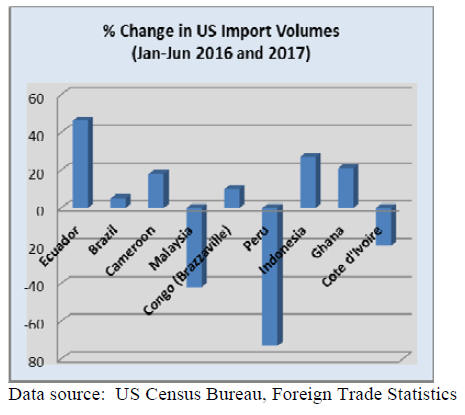|
Report from
North America
Tropical imports outpace temperate hardwoods in
June
Imports of sawn temperate and tropical hardwood grew
13% in June to 75,404 cu.m. The value of imports
increased just 2% in June to US$43 million. The overall
volume was lower than in June 2016 when the US
imported 86,178 cu.m. of sawn hardwood.
Imports of tropical species grew faster than temperate
hardwood imports in June. Tropical sawn hardwood
import volumes grew 17% from May to 22,402 cu.m.,
while the value of imports increased by 5%.
Much of the June growth was in imports of sapelli (4,717
cu.m.), balsa (5,506 cu.m.) and ˇ°other tropicalˇ± (3,083
cu.m.).
Ipe sawnwood imports fell by one third in June to 2,438
cu.m., but May imports had been quite high. Year-to-date
ipe imports were up 2% compared to June 2016.
Imports from Malaysia grew to 1,667 cu.m. in June, but
year-to-date imports were down 42% from June last year.
In June 2017 keruing accounted to half of all US
sawnwood imports from Malaysia, followed by ˇ°other
tropicalˇ±, meranti and teak.
Sawnwood imports from Indonesia were up in June, both
month-over-month and year-to-date. Over half of of the
1,368 cu.m. imported from Indonesia in June were ˇ°other
tropicalˇ±, followed by keruing, meranti and mahogany.
First half 2017 sawnwood imports
US imports of tropical sawnwood in the first half of 2017
were 9% higher than in the same period in 2016. However,
there were some significant changes in the sources of
tropical sawnwood.

Year on year 2017 imports from Peru dropped a massive
73% and imports from Malaysia were down 42%. On the
other hand US imports of sawnwood from Cameroon were
up 18% in the first half of this year and imports from the
Republic of the Congo rose 10% compared to 2016.
Canadian imports of meranti and ˇ°other tropicalˇ±
sawnwood rise
Canadian imports of tropical sawnwood were worth
USUS$1.65 million in June, down 24% from May. Yearto-
date imports were still 5% higher than in June 2016
because May imports had been exceptionally high.
Imports of all major species declined in June. Only
meranti imports were up (USUS$3,780) and imports of
ˇ°other tropicalˇ± (USUS$497,292). In fact the strongest
growth was in imports of tropical sawnwood not specified
in the trade classification system (ˇ°other tropicalˇ±).
Several countries grew sawnwood exports to Canada in
June despite the overall decline. Imports from Brazil
increased to USUS$147,781 in June. Sawnwood imports
from Congo (formerly Brazzaville), Indonesia, Malaysia
and the US were also up in June. Mahogany imports from
Congo/Brazzaville increased as did sapelli imports from
the US.
Sales halted of wood flooring linked to PNG logging
A Global Witness report of its investigation of the chain of
custody of timber from PNG to the US market via
manufacturing plants in China says taun (Pometia spp.)
flooring is manufactured in China from logs that are often
illegally harvested.
According to the report the concessions granted to logging
companies were often in violation of the rights of local
communities under PNG law.
The claims made by Global Witness have been challenged
by the Papua New Guinea Forest Industry Association
(PNGFIA) and a posting on the website of Forestry and
Development says ˇ°There is no basis for the claim that the
tiny amount of PNG timber that ends up in the US market
was harvested illegally.ˇ±
See:
http://forestryanddevelopment.com/site/2017/08/07/wester
n-activists-attack-pm-and-forest-exports/
EPA approves fourth accreditation body under new
formaldehyde emissions rule
The US Environmental Protection Agency (EPA) has
approved the American National Standards Institute
(ANSI) as an accreditation body to provide accreditation
services under the EPA's Formaldehyde Emissions
Standards for Composite Wood Products rule.
Accreditation bodies accredit and oversee EPA-recognized
Third-Party Certifiers who are responsible for certifying
that composite wood products are compliant with the
emissions standards found in the rule.
All producers of composite wood panels sold on the US
market are required to have their products tested by an
EPA-recognized Third-Party Certifier.
ANSI is the fourth accreditation body recognized by the
EPA.
The lists of EPA-recognized accreditation bodies and
Third-Party Certifiers are available on the EPA website:
https://www.epa.gov/formaldehyde/recognized-third-partycertifiers-
under-formaldehyde-emission-standards-compositewood
US bill could exacerbate construction labour shortage
say National Association of Home Builders
Two Republican senators have introduced a bill that would
reduce legal immigration by about half over the next
decade. Currently 1 million green cards for permanent
legal residence are given to immigrants every year.
The legislation would cut the annual number to just over
500,000. The bill includes restrictions for adult family
members and extended family of US residents and favour
higher skilled applicants for green cards. No changes are
planned to temporary, non-immigrant visa programs like
the H-2B non-agricultural worker visa.
The National Association of Home Builders (NAHB) is
concerned that the labour shortage in construction may
worsen without a new market-based visa programme.
The NAHB and other industry associations are expected to
lobby for a flexible program that will fill the current
labour gaps in construction and manufacturing.
Affordable Housing Credit Improvements Act to
promote construction of rental apartments
Another Senate bill introduced to address the housing
affordability crunch has been referred to the Senate
Finance Committee.
The bipartisan bill would boost construction by increasing
tax credits for low income housing, make a 4% credit rate
permanent, and include measures to preclude local
opposition to affordable housing projects.
The National Home Builders Association estimates an
additional 400,000 housing units would be built over the
next decade if the legislation passes.
|